Communicable Disease Essay: HIV Emerging and Re-Emerging Threat
VerifiedAdded on 2020/05/04
|16
|4940
|781
Essay
AI Summary
This essay provides a critical review of HIV as an emerging and re-emerging communicable disease. It explores the role of the pathogenic agent, discussing the virus's evolving capacity, transmission methods, and its impact on the host's immune system, including the destruction of CD4 cells and its ability to evade vaccine development. The essay also analyzes host factors, highlighting the genetic network governing the immune response and the impact of HIV on different immune cells. Environmental factors, such as socioeconomic conditions, lack of health literacy, and societal stigmas, are also examined in relation to the re-emergence of HIV. The essay further discusses the role of poverty and poor living conditions in facilitating the spread of the disease. The analysis considers the implications for public health and potential policy responses to combat the spread of HIV.

Running Head: COMMUNICABLE DISEASE
Communicable disease
Name of the Student
Name of the University
Author Note
Communicable disease
Name of the Student
Name of the University
Author Note
Paraphrase This Document
Need a fresh take? Get an instant paraphrase of this document with our AI Paraphraser
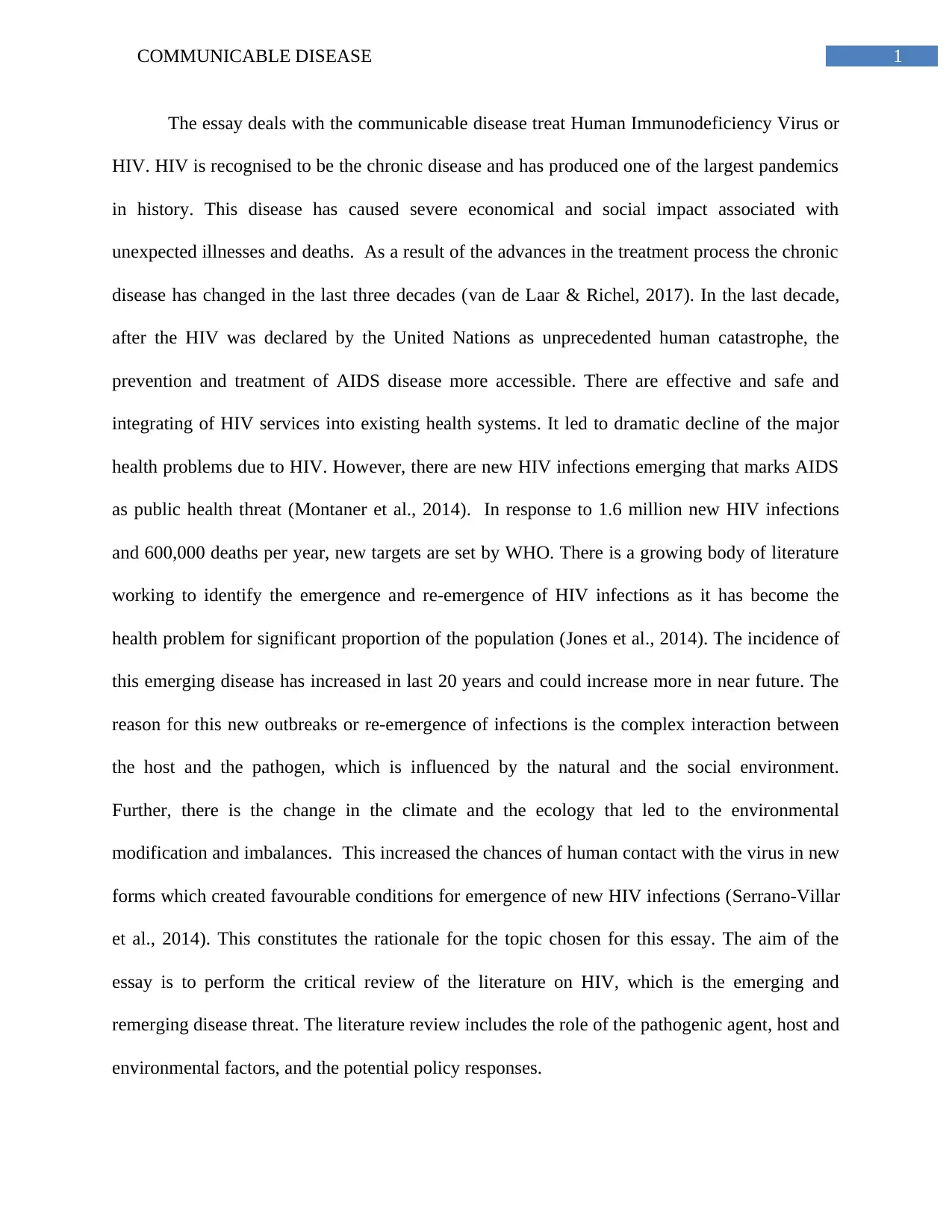
1COMMUNICABLE DISEASE
The essay deals with the communicable disease treat Human Immunodeficiency Virus or
HIV. HIV is recognised to be the chronic disease and has produced one of the largest pandemics
in history. This disease has caused severe economical and social impact associated with
unexpected illnesses and deaths. As a result of the advances in the treatment process the chronic
disease has changed in the last three decades (van de Laar & Richel, 2017). In the last decade,
after the HIV was declared by the United Nations as unprecedented human catastrophe, the
prevention and treatment of AIDS disease more accessible. There are effective and safe and
integrating of HIV services into existing health systems. It led to dramatic decline of the major
health problems due to HIV. However, there are new HIV infections emerging that marks AIDS
as public health threat (Montaner et al., 2014). In response to 1.6 million new HIV infections
and 600,000 deaths per year, new targets are set by WHO. There is a growing body of literature
working to identify the emergence and re-emergence of HIV infections as it has become the
health problem for significant proportion of the population (Jones et al., 2014). The incidence of
this emerging disease has increased in last 20 years and could increase more in near future. The
reason for this new outbreaks or re-emergence of infections is the complex interaction between
the host and the pathogen, which is influenced by the natural and the social environment.
Further, there is the change in the climate and the ecology that led to the environmental
modification and imbalances. This increased the chances of human contact with the virus in new
forms which created favourable conditions for emergence of new HIV infections (Serrano-Villar
et al., 2014). This constitutes the rationale for the topic chosen for this essay. The aim of the
essay is to perform the critical review of the literature on HIV, which is the emerging and
remerging disease threat. The literature review includes the role of the pathogenic agent, host and
environmental factors, and the potential policy responses.
The essay deals with the communicable disease treat Human Immunodeficiency Virus or
HIV. HIV is recognised to be the chronic disease and has produced one of the largest pandemics
in history. This disease has caused severe economical and social impact associated with
unexpected illnesses and deaths. As a result of the advances in the treatment process the chronic
disease has changed in the last three decades (van de Laar & Richel, 2017). In the last decade,
after the HIV was declared by the United Nations as unprecedented human catastrophe, the
prevention and treatment of AIDS disease more accessible. There are effective and safe and
integrating of HIV services into existing health systems. It led to dramatic decline of the major
health problems due to HIV. However, there are new HIV infections emerging that marks AIDS
as public health threat (Montaner et al., 2014). In response to 1.6 million new HIV infections
and 600,000 deaths per year, new targets are set by WHO. There is a growing body of literature
working to identify the emergence and re-emergence of HIV infections as it has become the
health problem for significant proportion of the population (Jones et al., 2014). The incidence of
this emerging disease has increased in last 20 years and could increase more in near future. The
reason for this new outbreaks or re-emergence of infections is the complex interaction between
the host and the pathogen, which is influenced by the natural and the social environment.
Further, there is the change in the climate and the ecology that led to the environmental
modification and imbalances. This increased the chances of human contact with the virus in new
forms which created favourable conditions for emergence of new HIV infections (Serrano-Villar
et al., 2014). This constitutes the rationale for the topic chosen for this essay. The aim of the
essay is to perform the critical review of the literature on HIV, which is the emerging and
remerging disease threat. The literature review includes the role of the pathogenic agent, host and
environmental factors, and the potential policy responses.
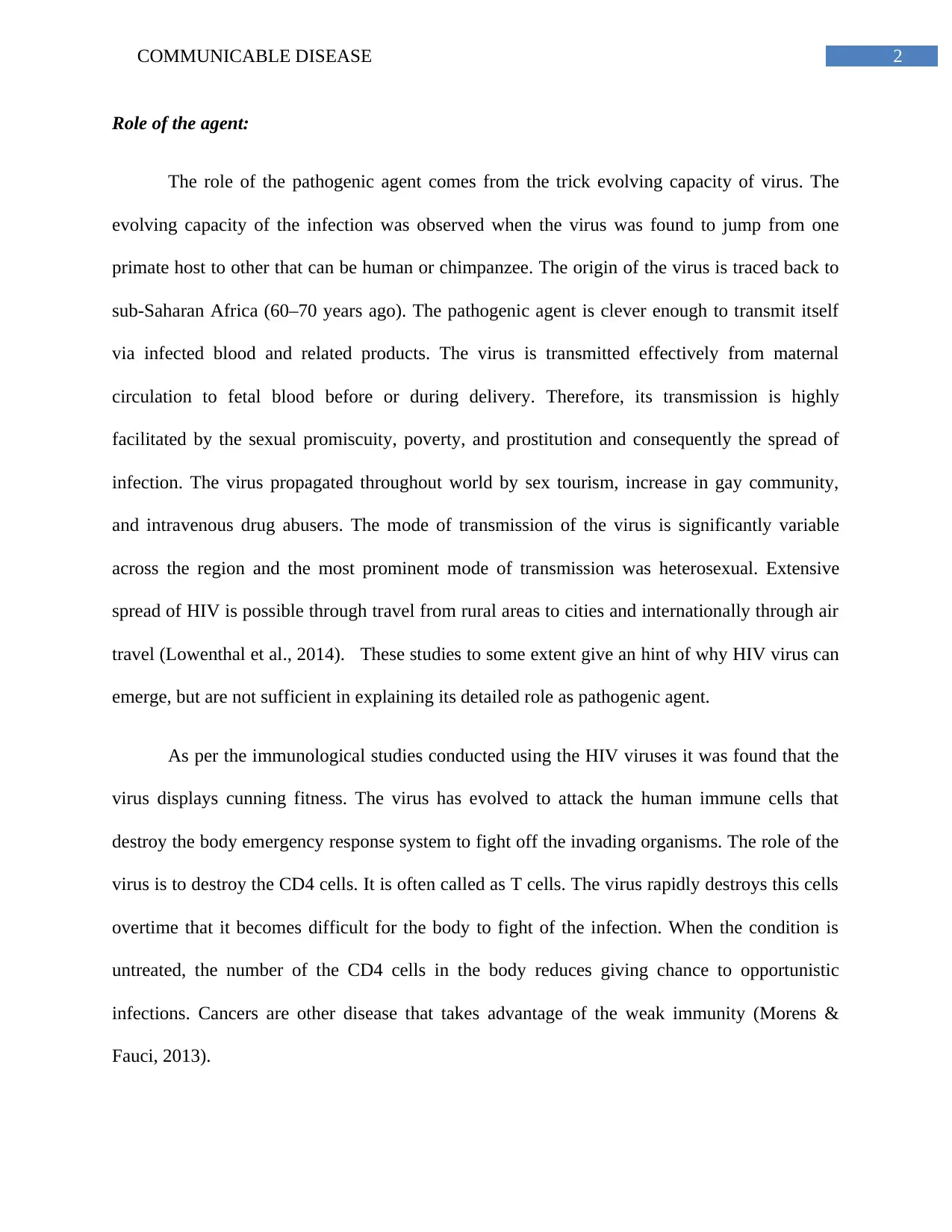
2COMMUNICABLE DISEASE
Role of the agent:
The role of the pathogenic agent comes from the trick evolving capacity of virus. The
evolving capacity of the infection was observed when the virus was found to jump from one
primate host to other that can be human or chimpanzee. The origin of the virus is traced back to
sub-Saharan Africa (60–70 years ago). The pathogenic agent is clever enough to transmit itself
via infected blood and related products. The virus is transmitted effectively from maternal
circulation to fetal blood before or during delivery. Therefore, its transmission is highly
facilitated by the sexual promiscuity, poverty, and prostitution and consequently the spread of
infection. The virus propagated throughout world by sex tourism, increase in gay community,
and intravenous drug abusers. The mode of transmission of the virus is significantly variable
across the region and the most prominent mode of transmission was heterosexual. Extensive
spread of HIV is possible through travel from rural areas to cities and internationally through air
travel (Lowenthal et al., 2014). These studies to some extent give an hint of why HIV virus can
emerge, but are not sufficient in explaining its detailed role as pathogenic agent.
As per the immunological studies conducted using the HIV viruses it was found that the
virus displays cunning fitness. The virus has evolved to attack the human immune cells that
destroy the body emergency response system to fight off the invading organisms. The role of the
virus is to destroy the CD4 cells. It is often called as T cells. The virus rapidly destroys this cells
overtime that it becomes difficult for the body to fight of the infection. When the condition is
untreated, the number of the CD4 cells in the body reduces giving chance to opportunistic
infections. Cancers are other disease that takes advantage of the weak immunity (Morens &
Fauci, 2013).
Role of the agent:
The role of the pathogenic agent comes from the trick evolving capacity of virus. The
evolving capacity of the infection was observed when the virus was found to jump from one
primate host to other that can be human or chimpanzee. The origin of the virus is traced back to
sub-Saharan Africa (60–70 years ago). The pathogenic agent is clever enough to transmit itself
via infected blood and related products. The virus is transmitted effectively from maternal
circulation to fetal blood before or during delivery. Therefore, its transmission is highly
facilitated by the sexual promiscuity, poverty, and prostitution and consequently the spread of
infection. The virus propagated throughout world by sex tourism, increase in gay community,
and intravenous drug abusers. The mode of transmission of the virus is significantly variable
across the region and the most prominent mode of transmission was heterosexual. Extensive
spread of HIV is possible through travel from rural areas to cities and internationally through air
travel (Lowenthal et al., 2014). These studies to some extent give an hint of why HIV virus can
emerge, but are not sufficient in explaining its detailed role as pathogenic agent.
As per the immunological studies conducted using the HIV viruses it was found that the
virus displays cunning fitness. The virus has evolved to attack the human immune cells that
destroy the body emergency response system to fight off the invading organisms. The role of the
virus is to destroy the CD4 cells. It is often called as T cells. The virus rapidly destroys this cells
overtime that it becomes difficult for the body to fight of the infection. When the condition is
untreated, the number of the CD4 cells in the body reduces giving chance to opportunistic
infections. Cancers are other disease that takes advantage of the weak immunity (Morens &
Fauci, 2013).
⊘ This is a preview!⊘
Do you want full access?
Subscribe today to unlock all pages.

Trusted by 1+ million students worldwide
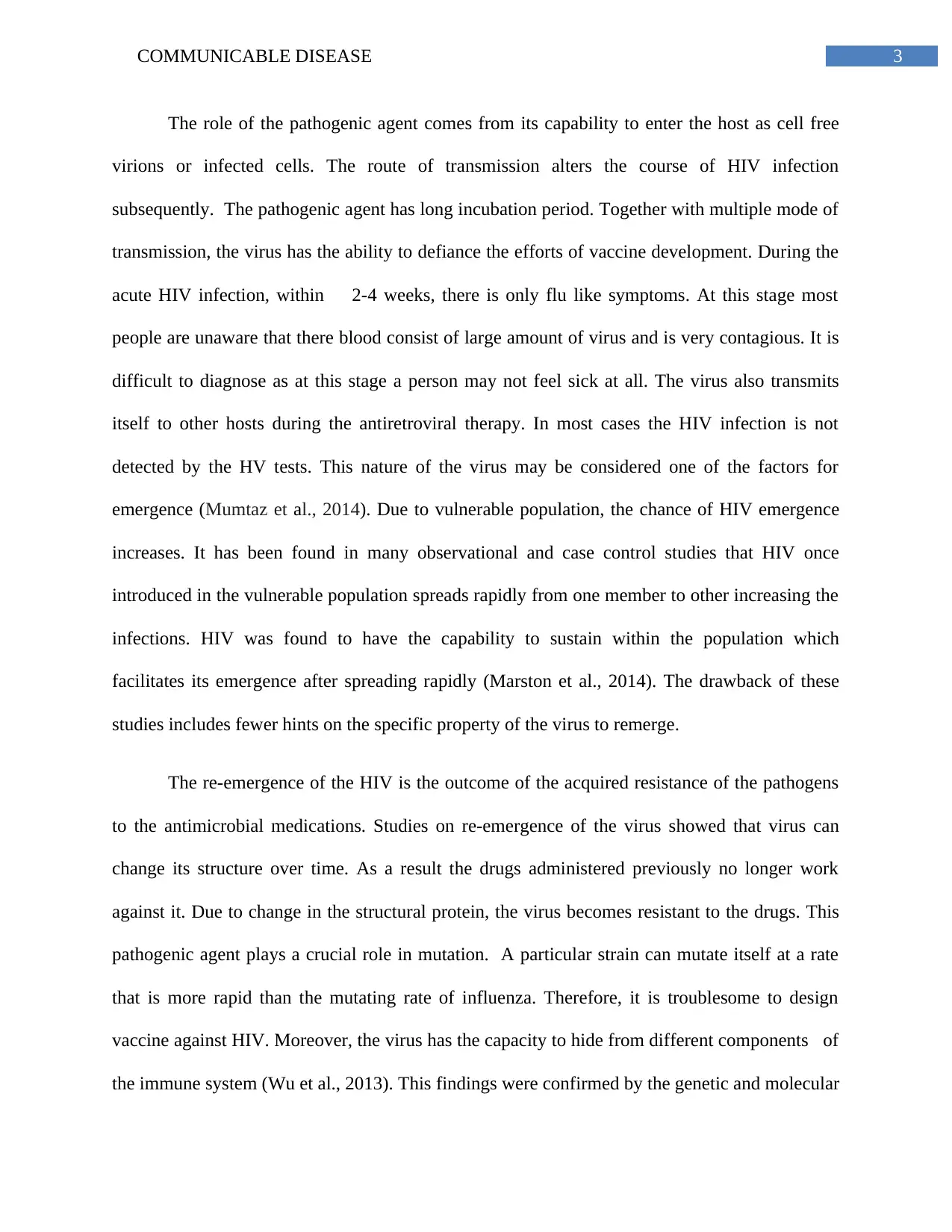
3COMMUNICABLE DISEASE
The role of the pathogenic agent comes from its capability to enter the host as cell free
virions or infected cells. The route of transmission alters the course of HIV infection
subsequently. The pathogenic agent has long incubation period. Together with multiple mode of
transmission, the virus has the ability to defiance the efforts of vaccine development. During the
acute HIV infection, within 2-4 weeks, there is only flu like symptoms. At this stage most
people are unaware that there blood consist of large amount of virus and is very contagious. It is
difficult to diagnose as at this stage a person may not feel sick at all. The virus also transmits
itself to other hosts during the antiretroviral therapy. In most cases the HIV infection is not
detected by the HV tests. This nature of the virus may be considered one of the factors for
emergence (Mumtaz et al., 2014). Due to vulnerable population, the chance of HIV emergence
increases. It has been found in many observational and case control studies that HIV once
introduced in the vulnerable population spreads rapidly from one member to other increasing the
infections. HIV was found to have the capability to sustain within the population which
facilitates its emergence after spreading rapidly (Marston et al., 2014). The drawback of these
studies includes fewer hints on the specific property of the virus to remerge.
The re-emergence of the HIV is the outcome of the acquired resistance of the pathogens
to the antimicrobial medications. Studies on re-emergence of the virus showed that virus can
change its structure over time. As a result the drugs administered previously no longer work
against it. Due to change in the structural protein, the virus becomes resistant to the drugs. This
pathogenic agent plays a crucial role in mutation. A particular strain can mutate itself at a rate
that is more rapid than the mutating rate of influenza. Therefore, it is troublesome to design
vaccine against HIV. Moreover, the virus has the capacity to hide from different components of
the immune system (Wu et al., 2013). This findings were confirmed by the genetic and molecular
The role of the pathogenic agent comes from its capability to enter the host as cell free
virions or infected cells. The route of transmission alters the course of HIV infection
subsequently. The pathogenic agent has long incubation period. Together with multiple mode of
transmission, the virus has the ability to defiance the efforts of vaccine development. During the
acute HIV infection, within 2-4 weeks, there is only flu like symptoms. At this stage most
people are unaware that there blood consist of large amount of virus and is very contagious. It is
difficult to diagnose as at this stage a person may not feel sick at all. The virus also transmits
itself to other hosts during the antiretroviral therapy. In most cases the HIV infection is not
detected by the HV tests. This nature of the virus may be considered one of the factors for
emergence (Mumtaz et al., 2014). Due to vulnerable population, the chance of HIV emergence
increases. It has been found in many observational and case control studies that HIV once
introduced in the vulnerable population spreads rapidly from one member to other increasing the
infections. HIV was found to have the capability to sustain within the population which
facilitates its emergence after spreading rapidly (Marston et al., 2014). The drawback of these
studies includes fewer hints on the specific property of the virus to remerge.
The re-emergence of the HIV is the outcome of the acquired resistance of the pathogens
to the antimicrobial medications. Studies on re-emergence of the virus showed that virus can
change its structure over time. As a result the drugs administered previously no longer work
against it. Due to change in the structural protein, the virus becomes resistant to the drugs. This
pathogenic agent plays a crucial role in mutation. A particular strain can mutate itself at a rate
that is more rapid than the mutating rate of influenza. Therefore, it is troublesome to design
vaccine against HIV. Moreover, the virus has the capacity to hide from different components of
the immune system (Wu et al., 2013). This findings were confirmed by the genetic and molecular
Paraphrase This Document
Need a fresh take? Get an instant paraphrase of this document with our AI Paraphraser
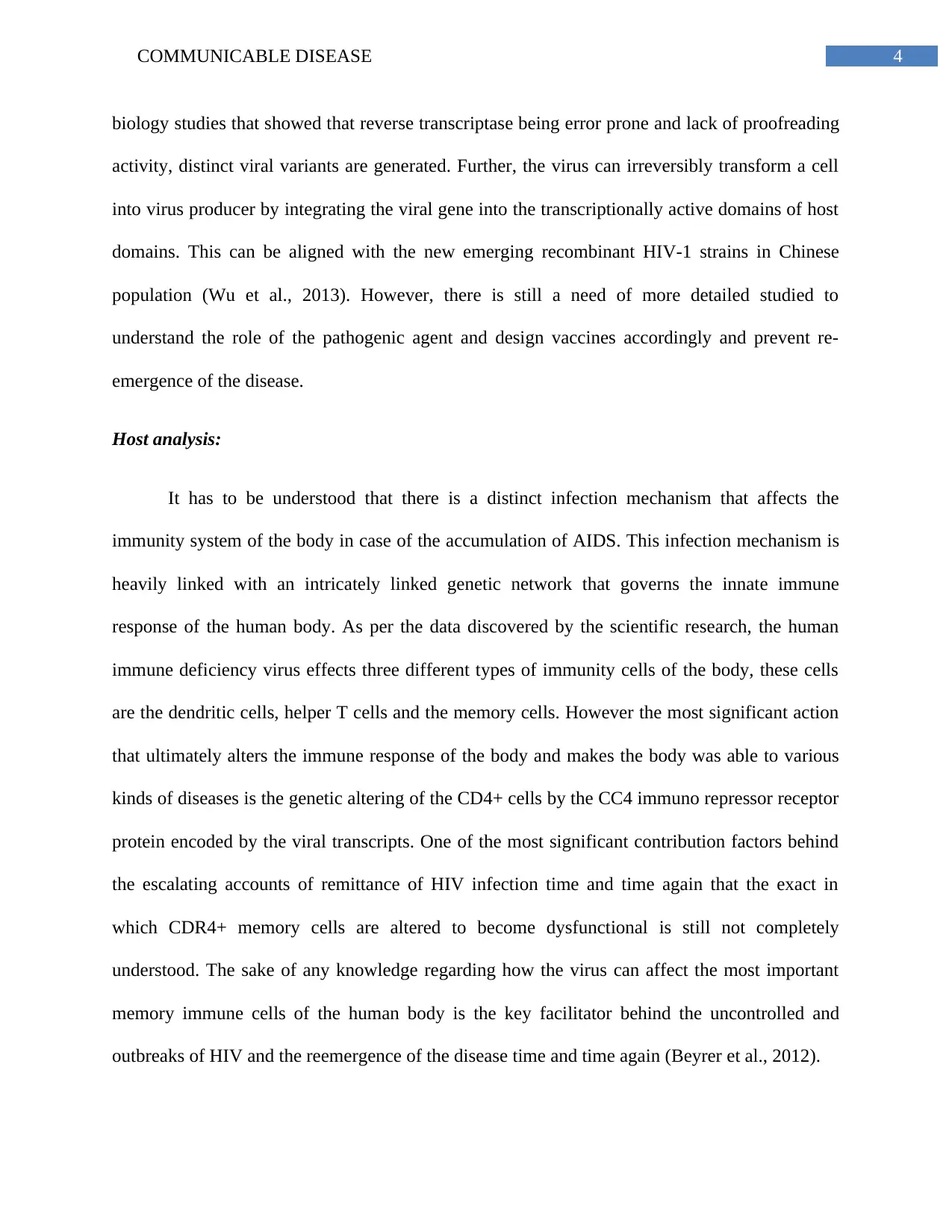
4COMMUNICABLE DISEASE
biology studies that showed that reverse transcriptase being error prone and lack of proofreading
activity, distinct viral variants are generated. Further, the virus can irreversibly transform a cell
into virus producer by integrating the viral gene into the transcriptionally active domains of host
domains. This can be aligned with the new emerging recombinant HIV-1 strains in Chinese
population (Wu et al., 2013). However, there is still a need of more detailed studied to
understand the role of the pathogenic agent and design vaccines accordingly and prevent re-
emergence of the disease.
Host analysis:
It has to be understood that there is a distinct infection mechanism that affects the
immunity system of the body in case of the accumulation of AIDS. This infection mechanism is
heavily linked with an intricately linked genetic network that governs the innate immune
response of the human body. As per the data discovered by the scientific research, the human
immune deficiency virus effects three different types of immunity cells of the body, these cells
are the dendritic cells, helper T cells and the memory cells. However the most significant action
that ultimately alters the immune response of the body and makes the body was able to various
kinds of diseases is the genetic altering of the CD4+ cells by the CC4 immuno repressor receptor
protein encoded by the viral transcripts. One of the most significant contribution factors behind
the escalating accounts of remittance of HIV infection time and time again that the exact in
which CDR4+ memory cells are altered to become dysfunctional is still not completely
understood. The sake of any knowledge regarding how the virus can affect the most important
memory immune cells of the human body is the key facilitator behind the uncontrolled and
outbreaks of HIV and the reemergence of the disease time and time again (Beyrer et al., 2012).
biology studies that showed that reverse transcriptase being error prone and lack of proofreading
activity, distinct viral variants are generated. Further, the virus can irreversibly transform a cell
into virus producer by integrating the viral gene into the transcriptionally active domains of host
domains. This can be aligned with the new emerging recombinant HIV-1 strains in Chinese
population (Wu et al., 2013). However, there is still a need of more detailed studied to
understand the role of the pathogenic agent and design vaccines accordingly and prevent re-
emergence of the disease.
Host analysis:
It has to be understood that there is a distinct infection mechanism that affects the
immunity system of the body in case of the accumulation of AIDS. This infection mechanism is
heavily linked with an intricately linked genetic network that governs the innate immune
response of the human body. As per the data discovered by the scientific research, the human
immune deficiency virus effects three different types of immunity cells of the body, these cells
are the dendritic cells, helper T cells and the memory cells. However the most significant action
that ultimately alters the immune response of the body and makes the body was able to various
kinds of diseases is the genetic altering of the CD4+ cells by the CC4 immuno repressor receptor
protein encoded by the viral transcripts. One of the most significant contribution factors behind
the escalating accounts of remittance of HIV infection time and time again that the exact in
which CDR4+ memory cells are altered to become dysfunctional is still not completely
understood. The sake of any knowledge regarding how the virus can affect the most important
memory immune cells of the human body is the key facilitator behind the uncontrolled and
outbreaks of HIV and the reemergence of the disease time and time again (Beyrer et al., 2012).
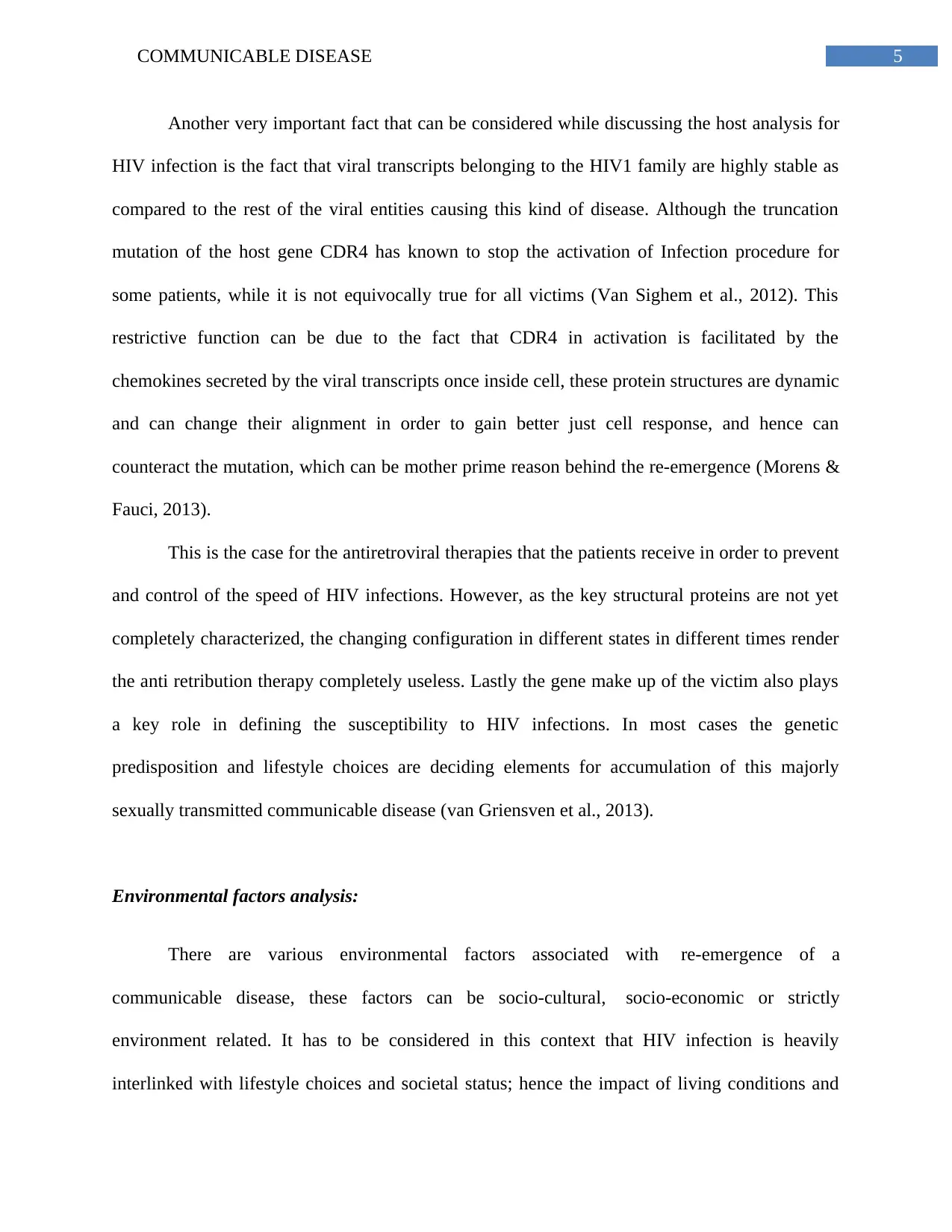
5COMMUNICABLE DISEASE
Another very important fact that can be considered while discussing the host analysis for
HIV infection is the fact that viral transcripts belonging to the HIV1 family are highly stable as
compared to the rest of the viral entities causing this kind of disease. Although the truncation
mutation of the host gene CDR4 has known to stop the activation of Infection procedure for
some patients, while it is not equivocally true for all victims (Van Sighem et al., 2012). This
restrictive function can be due to the fact that CDR4 in activation is facilitated by the
chemokines secreted by the viral transcripts once inside cell, these protein structures are dynamic
and can change their alignment in order to gain better just cell response, and hence can
counteract the mutation, which can be mother prime reason behind the re-emergence (Morens &
Fauci, 2013).
This is the case for the antiretroviral therapies that the patients receive in order to prevent
and control of the speed of HIV infections. However, as the key structural proteins are not yet
completely characterized, the changing configuration in different states in different times render
the anti retribution therapy completely useless. Lastly the gene make up of the victim also plays
a key role in defining the susceptibility to HIV infections. In most cases the genetic
predisposition and lifestyle choices are deciding elements for accumulation of this majorly
sexually transmitted communicable disease (van Griensven et al., 2013).
Environmental factors analysis:
There are various environmental factors associated with re-emergence of a
communicable disease, these factors can be socio-cultural, socio-economic or strictly
environment related. It has to be considered in this context that HIV infection is heavily
interlinked with lifestyle choices and societal status; hence the impact of living conditions and
Another very important fact that can be considered while discussing the host analysis for
HIV infection is the fact that viral transcripts belonging to the HIV1 family are highly stable as
compared to the rest of the viral entities causing this kind of disease. Although the truncation
mutation of the host gene CDR4 has known to stop the activation of Infection procedure for
some patients, while it is not equivocally true for all victims (Van Sighem et al., 2012). This
restrictive function can be due to the fact that CDR4 in activation is facilitated by the
chemokines secreted by the viral transcripts once inside cell, these protein structures are dynamic
and can change their alignment in order to gain better just cell response, and hence can
counteract the mutation, which can be mother prime reason behind the re-emergence (Morens &
Fauci, 2013).
This is the case for the antiretroviral therapies that the patients receive in order to prevent
and control of the speed of HIV infections. However, as the key structural proteins are not yet
completely characterized, the changing configuration in different states in different times render
the anti retribution therapy completely useless. Lastly the gene make up of the victim also plays
a key role in defining the susceptibility to HIV infections. In most cases the genetic
predisposition and lifestyle choices are deciding elements for accumulation of this majorly
sexually transmitted communicable disease (van Griensven et al., 2013).
Environmental factors analysis:
There are various environmental factors associated with re-emergence of a
communicable disease, these factors can be socio-cultural, socio-economic or strictly
environment related. It has to be considered in this context that HIV infection is heavily
interlinked with lifestyle choices and societal status; hence the impact of living conditions and
⊘ This is a preview!⊘
Do you want full access?
Subscribe today to unlock all pages.

Trusted by 1+ million students worldwide
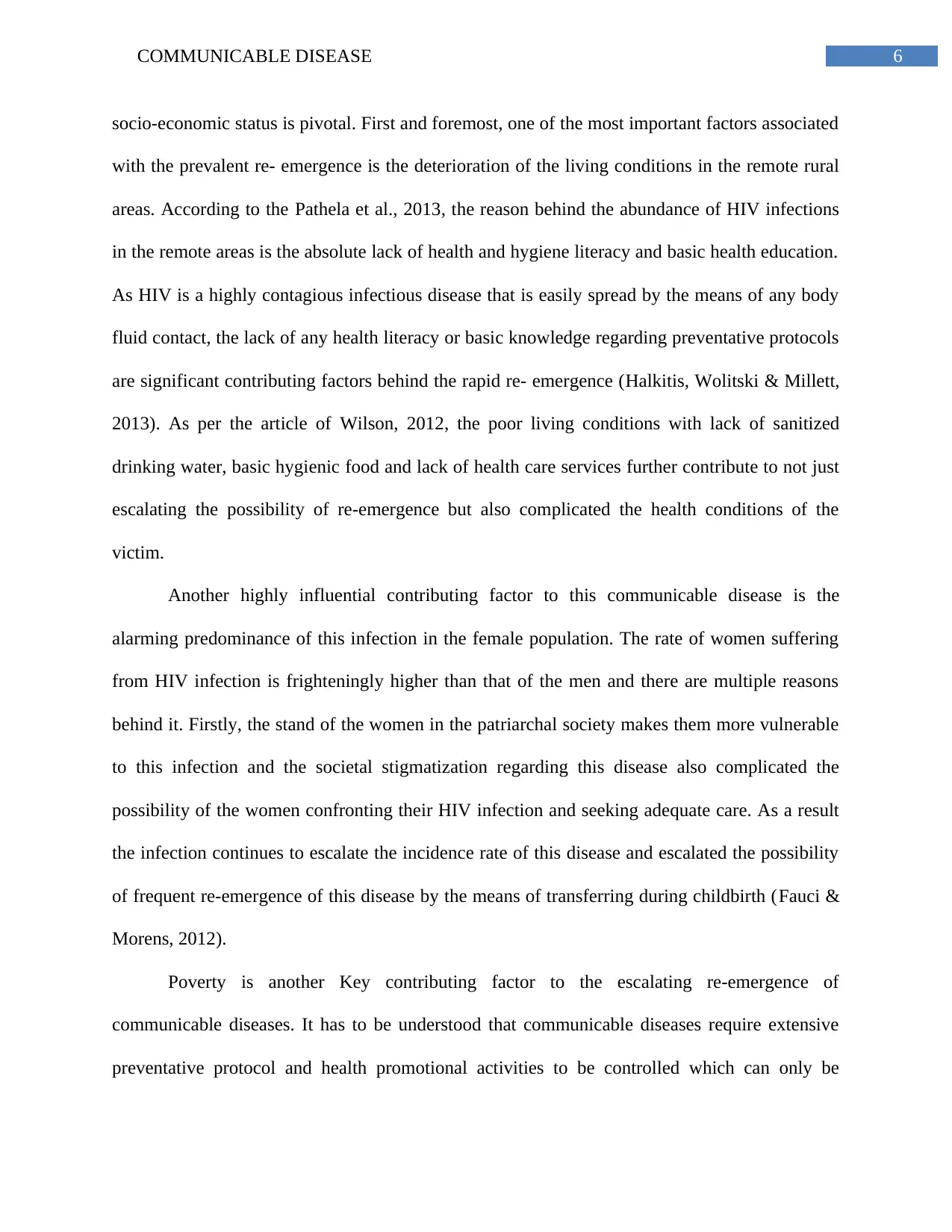
6COMMUNICABLE DISEASE
socio-economic status is pivotal. First and foremost, one of the most important factors associated
with the prevalent re- emergence is the deterioration of the living conditions in the remote rural
areas. According to the Pathela et al., 2013, the reason behind the abundance of HIV infections
in the remote areas is the absolute lack of health and hygiene literacy and basic health education.
As HIV is a highly contagious infectious disease that is easily spread by the means of any body
fluid contact, the lack of any health literacy or basic knowledge regarding preventative protocols
are significant contributing factors behind the rapid re- emergence (Halkitis, Wolitski & Millett,
2013). As per the article of Wilson, 2012, the poor living conditions with lack of sanitized
drinking water, basic hygienic food and lack of health care services further contribute to not just
escalating the possibility of re-emergence but also complicated the health conditions of the
victim.
Another highly influential contributing factor to this communicable disease is the
alarming predominance of this infection in the female population. The rate of women suffering
from HIV infection is frighteningly higher than that of the men and there are multiple reasons
behind it. Firstly, the stand of the women in the patriarchal society makes them more vulnerable
to this infection and the societal stigmatization regarding this disease also complicated the
possibility of the women confronting their HIV infection and seeking adequate care. As a result
the infection continues to escalate the incidence rate of this disease and escalated the possibility
of frequent re-emergence of this disease by the means of transferring during childbirth (Fauci &
Morens, 2012).
Poverty is another Key contributing factor to the escalating re-emergence of
communicable diseases. It has to be understood that communicable diseases require extensive
preventative protocol and health promotional activities to be controlled which can only be
socio-economic status is pivotal. First and foremost, one of the most important factors associated
with the prevalent re- emergence is the deterioration of the living conditions in the remote rural
areas. According to the Pathela et al., 2013, the reason behind the abundance of HIV infections
in the remote areas is the absolute lack of health and hygiene literacy and basic health education.
As HIV is a highly contagious infectious disease that is easily spread by the means of any body
fluid contact, the lack of any health literacy or basic knowledge regarding preventative protocols
are significant contributing factors behind the rapid re- emergence (Halkitis, Wolitski & Millett,
2013). As per the article of Wilson, 2012, the poor living conditions with lack of sanitized
drinking water, basic hygienic food and lack of health care services further contribute to not just
escalating the possibility of re-emergence but also complicated the health conditions of the
victim.
Another highly influential contributing factor to this communicable disease is the
alarming predominance of this infection in the female population. The rate of women suffering
from HIV infection is frighteningly higher than that of the men and there are multiple reasons
behind it. Firstly, the stand of the women in the patriarchal society makes them more vulnerable
to this infection and the societal stigmatization regarding this disease also complicated the
possibility of the women confronting their HIV infection and seeking adequate care. As a result
the infection continues to escalate the incidence rate of this disease and escalated the possibility
of frequent re-emergence of this disease by the means of transferring during childbirth (Fauci &
Morens, 2012).
Poverty is another Key contributing factor to the escalating re-emergence of
communicable diseases. It has to be understood that communicable diseases require extensive
preventative protocol and health promotional activities to be controlled which can only be
Paraphrase This Document
Need a fresh take? Get an instant paraphrase of this document with our AI Paraphraser
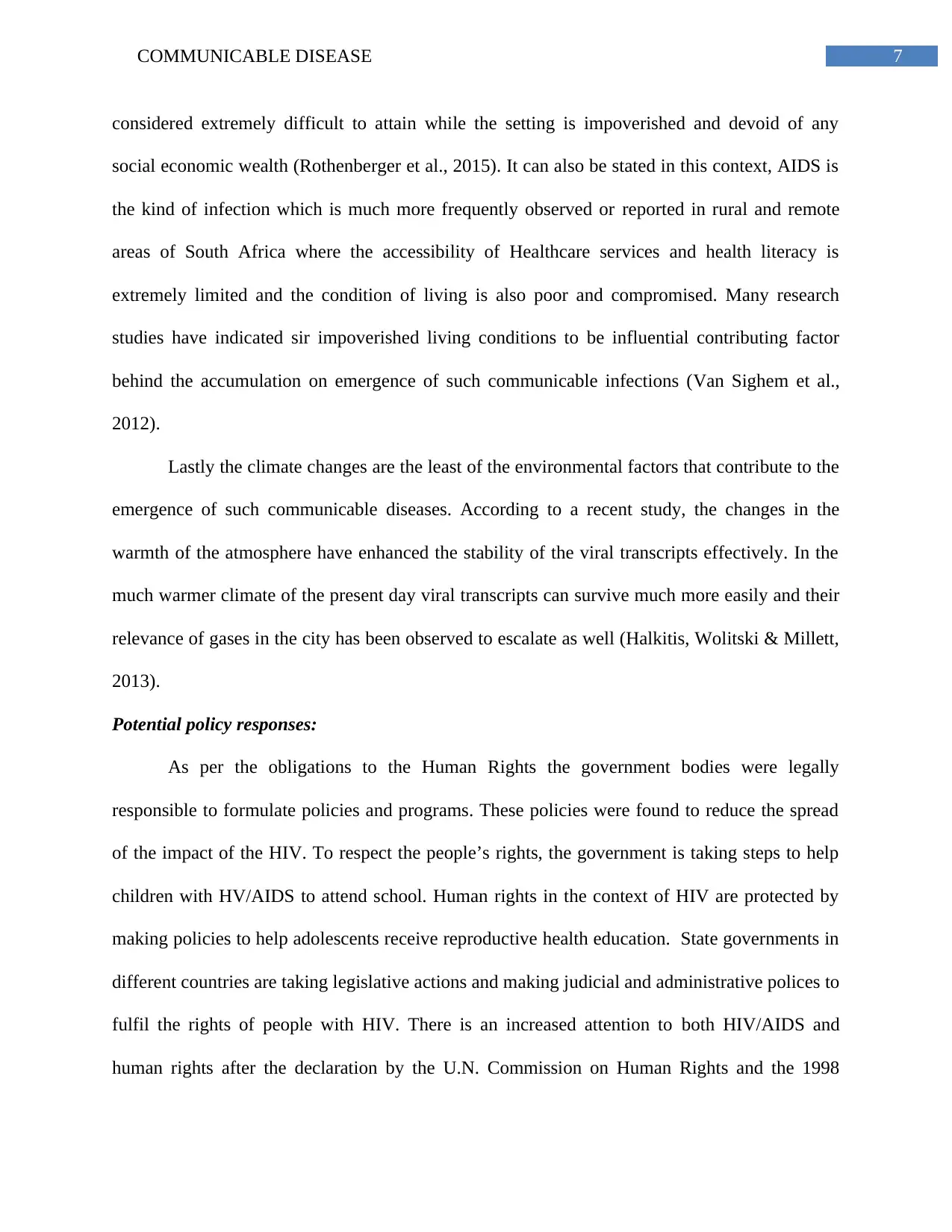
7COMMUNICABLE DISEASE
considered extremely difficult to attain while the setting is impoverished and devoid of any
social economic wealth (Rothenberger et al., 2015). It can also be stated in this context, AIDS is
the kind of infection which is much more frequently observed or reported in rural and remote
areas of South Africa where the accessibility of Healthcare services and health literacy is
extremely limited and the condition of living is also poor and compromised. Many research
studies have indicated sir impoverished living conditions to be influential contributing factor
behind the accumulation on emergence of such communicable infections (Van Sighem et al.,
2012).
Lastly the climate changes are the least of the environmental factors that contribute to the
emergence of such communicable diseases. According to a recent study, the changes in the
warmth of the atmosphere have enhanced the stability of the viral transcripts effectively. In the
much warmer climate of the present day viral transcripts can survive much more easily and their
relevance of gases in the city has been observed to escalate as well (Halkitis, Wolitski & Millett,
2013).
Potential policy responses:
As per the obligations to the Human Rights the government bodies were legally
responsible to formulate policies and programs. These policies were found to reduce the spread
of the impact of the HIV. To respect the people’s rights, the government is taking steps to help
children with HV/AIDS to attend school. Human rights in the context of HIV are protected by
making policies to help adolescents receive reproductive health education. State governments in
different countries are taking legislative actions and making judicial and administrative polices to
fulfil the rights of people with HIV. There is an increased attention to both HIV/AIDS and
human rights after the declaration by the U.N. Commission on Human Rights and the 1998
considered extremely difficult to attain while the setting is impoverished and devoid of any
social economic wealth (Rothenberger et al., 2015). It can also be stated in this context, AIDS is
the kind of infection which is much more frequently observed or reported in rural and remote
areas of South Africa where the accessibility of Healthcare services and health literacy is
extremely limited and the condition of living is also poor and compromised. Many research
studies have indicated sir impoverished living conditions to be influential contributing factor
behind the accumulation on emergence of such communicable infections (Van Sighem et al.,
2012).
Lastly the climate changes are the least of the environmental factors that contribute to the
emergence of such communicable diseases. According to a recent study, the changes in the
warmth of the atmosphere have enhanced the stability of the viral transcripts effectively. In the
much warmer climate of the present day viral transcripts can survive much more easily and their
relevance of gases in the city has been observed to escalate as well (Halkitis, Wolitski & Millett,
2013).
Potential policy responses:
As per the obligations to the Human Rights the government bodies were legally
responsible to formulate policies and programs. These policies were found to reduce the spread
of the impact of the HIV. To respect the people’s rights, the government is taking steps to help
children with HV/AIDS to attend school. Human rights in the context of HIV are protected by
making policies to help adolescents receive reproductive health education. State governments in
different countries are taking legislative actions and making judicial and administrative polices to
fulfil the rights of people with HIV. There is an increased attention to both HIV/AIDS and
human rights after the declaration by the U.N. Commission on Human Rights and the 1998
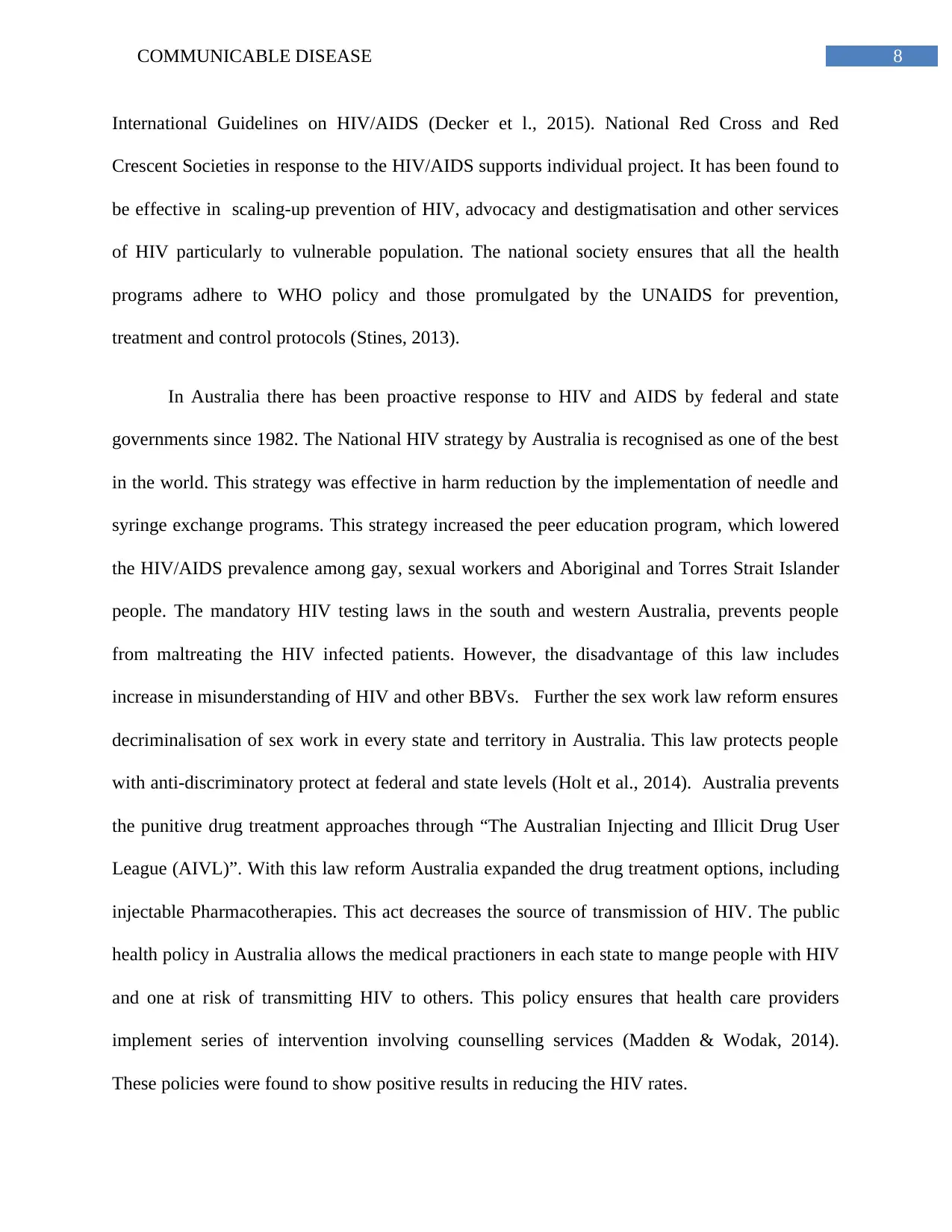
8COMMUNICABLE DISEASE
International Guidelines on HIV/AIDS (Decker et l., 2015). National Red Cross and Red
Crescent Societies in response to the HIV/AIDS supports individual project. It has been found to
be effective in scaling-up prevention of HIV, advocacy and destigmatisation and other services
of HIV particularly to vulnerable population. The national society ensures that all the health
programs adhere to WHO policy and those promulgated by the UNAIDS for prevention,
treatment and control protocols (Stines, 2013).
In Australia there has been proactive response to HIV and AIDS by federal and state
governments since 1982. The National HIV strategy by Australia is recognised as one of the best
in the world. This strategy was effective in harm reduction by the implementation of needle and
syringe exchange programs. This strategy increased the peer education program, which lowered
the HIV/AIDS prevalence among gay, sexual workers and Aboriginal and Torres Strait Islander
people. The mandatory HIV testing laws in the south and western Australia, prevents people
from maltreating the HIV infected patients. However, the disadvantage of this law includes
increase in misunderstanding of HIV and other BBVs. Further the sex work law reform ensures
decriminalisation of sex work in every state and territory in Australia. This law protects people
with anti-discriminatory protect at federal and state levels (Holt et al., 2014). Australia prevents
the punitive drug treatment approaches through “The Australian Injecting and Illicit Drug User
League (AIVL)”. With this law reform Australia expanded the drug treatment options, including
injectable Pharmacotherapies. This act decreases the source of transmission of HIV. The public
health policy in Australia allows the medical practioners in each state to mange people with HIV
and one at risk of transmitting HIV to others. This policy ensures that health care providers
implement series of intervention involving counselling services (Madden & Wodak, 2014).
These policies were found to show positive results in reducing the HIV rates.
International Guidelines on HIV/AIDS (Decker et l., 2015). National Red Cross and Red
Crescent Societies in response to the HIV/AIDS supports individual project. It has been found to
be effective in scaling-up prevention of HIV, advocacy and destigmatisation and other services
of HIV particularly to vulnerable population. The national society ensures that all the health
programs adhere to WHO policy and those promulgated by the UNAIDS for prevention,
treatment and control protocols (Stines, 2013).
In Australia there has been proactive response to HIV and AIDS by federal and state
governments since 1982. The National HIV strategy by Australia is recognised as one of the best
in the world. This strategy was effective in harm reduction by the implementation of needle and
syringe exchange programs. This strategy increased the peer education program, which lowered
the HIV/AIDS prevalence among gay, sexual workers and Aboriginal and Torres Strait Islander
people. The mandatory HIV testing laws in the south and western Australia, prevents people
from maltreating the HIV infected patients. However, the disadvantage of this law includes
increase in misunderstanding of HIV and other BBVs. Further the sex work law reform ensures
decriminalisation of sex work in every state and territory in Australia. This law protects people
with anti-discriminatory protect at federal and state levels (Holt et al., 2014). Australia prevents
the punitive drug treatment approaches through “The Australian Injecting and Illicit Drug User
League (AIVL)”. With this law reform Australia expanded the drug treatment options, including
injectable Pharmacotherapies. This act decreases the source of transmission of HIV. The public
health policy in Australia allows the medical practioners in each state to mange people with HIV
and one at risk of transmitting HIV to others. This policy ensures that health care providers
implement series of intervention involving counselling services (Madden & Wodak, 2014).
These policies were found to show positive results in reducing the HIV rates.
⊘ This is a preview!⊘
Do you want full access?
Subscribe today to unlock all pages.

Trusted by 1+ million students worldwide

9COMMUNICABLE DISEASE
The seventh National HIV strategy 2014-2017 is found to be useful in decreasing the
trends of new HIV diagnosis. With this strategy Australia is working towards virtual elimination
of HIV transmission by 2020. This strategy is working with discrete targets which are informed
by the “United Nations 2011 United Nations Political Declaration on HIV/ and AIDS” (Kidd,
2014). These policy although could not prevent emergence but was helpful in decreasing
incidence and prevalence to great extent.
Recommendation for avoidance:
Despite of HIV being one of the most highly contagious and threatening communicable
disease, there are a few recommendations that can help in preventing and controlling the extent
of the outbreaks (Pathela et al., 2013).
First and foremost it has to be understood that is essentially a sexually transmitted
disease, hence the best preventative action is the widespread understanding and usage of
preventative protections. Along with that, in the remote and rural areas, the lack of any
health literacy provokes the spread of the disease; hence a basic HIV safety and
preventative education can help in reducing the incidence rate of the disease (Davis et al.,
2013).
Antiretroviral therapy despite its flaws still continues to be one of the most effective
clinical therapies to prevent AIDs. There is need for an effective strategy involving the
antiretroviral therapy as a nation-wide preventative strategy for controlling the spread of
the infection (Smith et al., 2013).
The seventh National HIV strategy 2014-2017 is found to be useful in decreasing the
trends of new HIV diagnosis. With this strategy Australia is working towards virtual elimination
of HIV transmission by 2020. This strategy is working with discrete targets which are informed
by the “United Nations 2011 United Nations Political Declaration on HIV/ and AIDS” (Kidd,
2014). These policy although could not prevent emergence but was helpful in decreasing
incidence and prevalence to great extent.
Recommendation for avoidance:
Despite of HIV being one of the most highly contagious and threatening communicable
disease, there are a few recommendations that can help in preventing and controlling the extent
of the outbreaks (Pathela et al., 2013).
First and foremost it has to be understood that is essentially a sexually transmitted
disease, hence the best preventative action is the widespread understanding and usage of
preventative protections. Along with that, in the remote and rural areas, the lack of any
health literacy provokes the spread of the disease; hence a basic HIV safety and
preventative education can help in reducing the incidence rate of the disease (Davis et al.,
2013).
Antiretroviral therapy despite its flaws still continues to be one of the most effective
clinical therapies to prevent AIDs. There is need for an effective strategy involving the
antiretroviral therapy as a nation-wide preventative strategy for controlling the spread of
the infection (Smith et al., 2013).
Paraphrase This Document
Need a fresh take? Get an instant paraphrase of this document with our AI Paraphraser
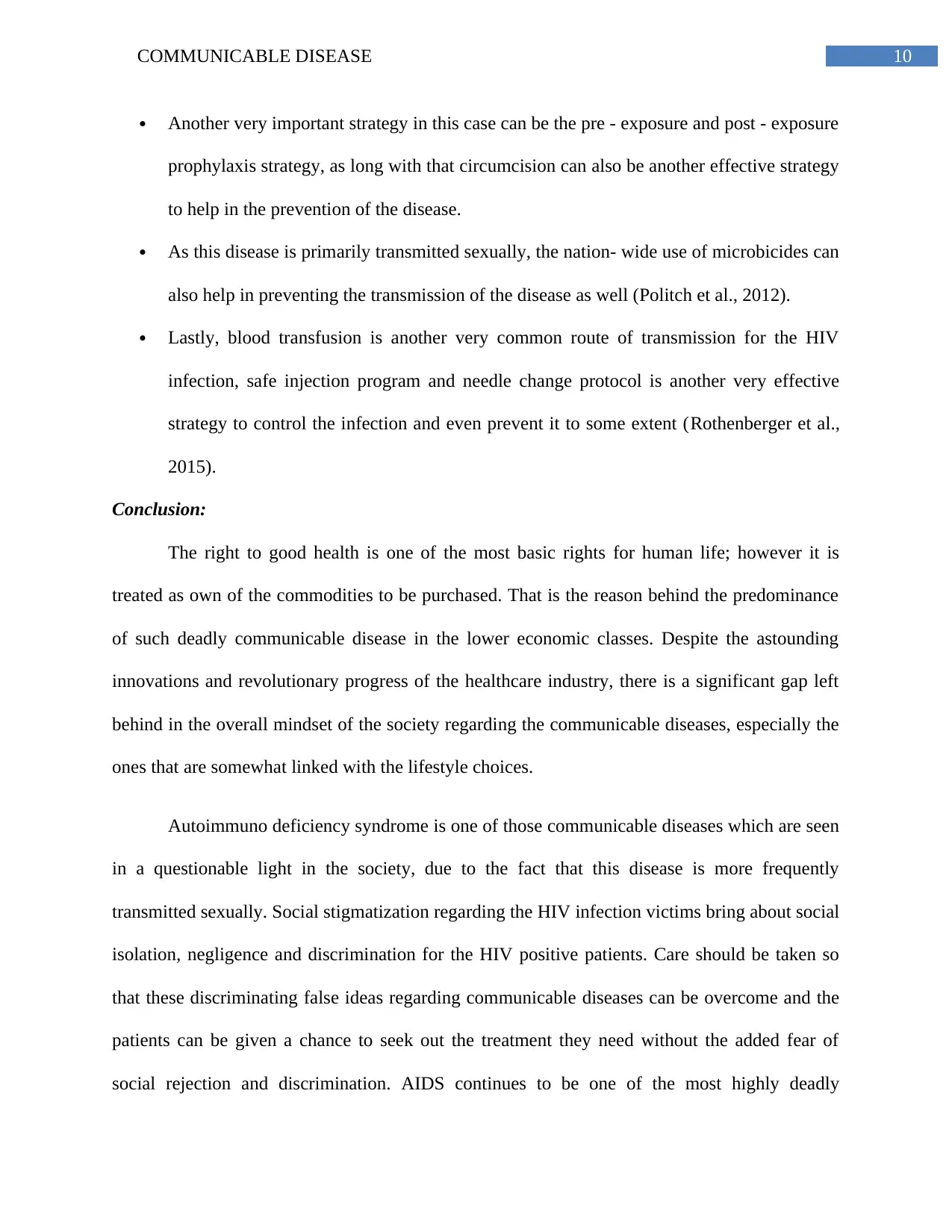
10COMMUNICABLE DISEASE
Another very important strategy in this case can be the pre - exposure and post - exposure
prophylaxis strategy, as long with that circumcision can also be another effective strategy
to help in the prevention of the disease.
As this disease is primarily transmitted sexually, the nation- wide use of microbicides can
also help in preventing the transmission of the disease as well (Politch et al., 2012).
Lastly, blood transfusion is another very common route of transmission for the HIV
infection, safe injection program and needle change protocol is another very effective
strategy to control the infection and even prevent it to some extent (Rothenberger et al.,
2015).
Conclusion:
The right to good health is one of the most basic rights for human life; however it is
treated as own of the commodities to be purchased. That is the reason behind the predominance
of such deadly communicable disease in the lower economic classes. Despite the astounding
innovations and revolutionary progress of the healthcare industry, there is a significant gap left
behind in the overall mindset of the society regarding the communicable diseases, especially the
ones that are somewhat linked with the lifestyle choices.
Autoimmuno deficiency syndrome is one of those communicable diseases which are seen
in a questionable light in the society, due to the fact that this disease is more frequently
transmitted sexually. Social stigmatization regarding the HIV infection victims bring about social
isolation, negligence and discrimination for the HIV positive patients. Care should be taken so
that these discriminating false ideas regarding communicable diseases can be overcome and the
patients can be given a chance to seek out the treatment they need without the added fear of
social rejection and discrimination. AIDS continues to be one of the most highly deadly
Another very important strategy in this case can be the pre - exposure and post - exposure
prophylaxis strategy, as long with that circumcision can also be another effective strategy
to help in the prevention of the disease.
As this disease is primarily transmitted sexually, the nation- wide use of microbicides can
also help in preventing the transmission of the disease as well (Politch et al., 2012).
Lastly, blood transfusion is another very common route of transmission for the HIV
infection, safe injection program and needle change protocol is another very effective
strategy to control the infection and even prevent it to some extent (Rothenberger et al.,
2015).
Conclusion:
The right to good health is one of the most basic rights for human life; however it is
treated as own of the commodities to be purchased. That is the reason behind the predominance
of such deadly communicable disease in the lower economic classes. Despite the astounding
innovations and revolutionary progress of the healthcare industry, there is a significant gap left
behind in the overall mindset of the society regarding the communicable diseases, especially the
ones that are somewhat linked with the lifestyle choices.
Autoimmuno deficiency syndrome is one of those communicable diseases which are seen
in a questionable light in the society, due to the fact that this disease is more frequently
transmitted sexually. Social stigmatization regarding the HIV infection victims bring about social
isolation, negligence and discrimination for the HIV positive patients. Care should be taken so
that these discriminating false ideas regarding communicable diseases can be overcome and the
patients can be given a chance to seek out the treatment they need without the added fear of
social rejection and discrimination. AIDS continues to be one of the most highly deadly
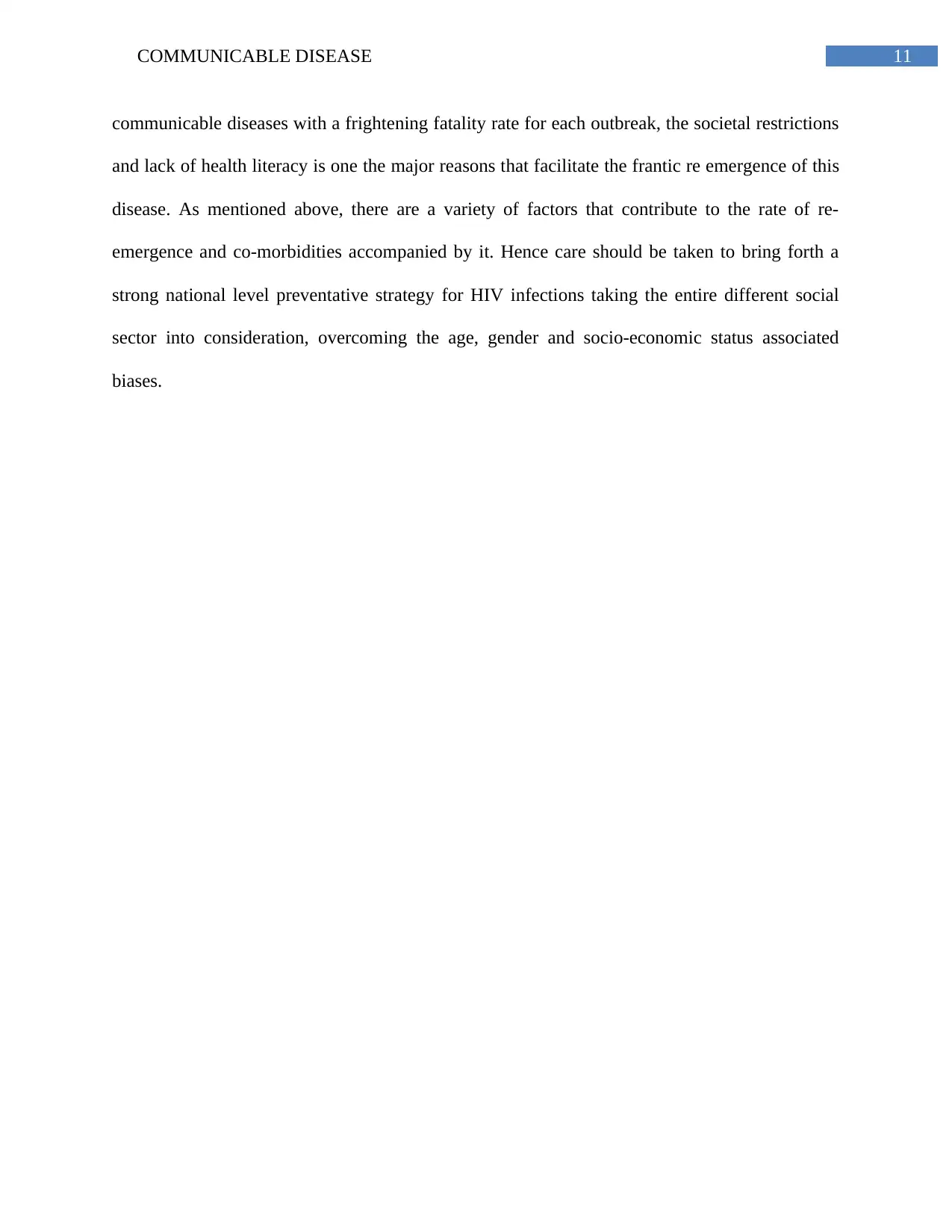
11COMMUNICABLE DISEASE
communicable diseases with a frightening fatality rate for each outbreak, the societal restrictions
and lack of health literacy is one the major reasons that facilitate the frantic re emergence of this
disease. As mentioned above, there are a variety of factors that contribute to the rate of re-
emergence and co-morbidities accompanied by it. Hence care should be taken to bring forth a
strong national level preventative strategy for HIV infections taking the entire different social
sector into consideration, overcoming the age, gender and socio-economic status associated
biases.
communicable diseases with a frightening fatality rate for each outbreak, the societal restrictions
and lack of health literacy is one the major reasons that facilitate the frantic re emergence of this
disease. As mentioned above, there are a variety of factors that contribute to the rate of re-
emergence and co-morbidities accompanied by it. Hence care should be taken to bring forth a
strong national level preventative strategy for HIV infections taking the entire different social
sector into consideration, overcoming the age, gender and socio-economic status associated
biases.
⊘ This is a preview!⊘
Do you want full access?
Subscribe today to unlock all pages.

Trusted by 1+ million students worldwide
1 out of 16
Related Documents
Your All-in-One AI-Powered Toolkit for Academic Success.
+13062052269
info@desklib.com
Available 24*7 on WhatsApp / Email
![[object Object]](/_next/static/media/star-bottom.7253800d.svg)
Unlock your academic potential
Copyright © 2020–2025 A2Z Services. All Rights Reserved. Developed and managed by ZUCOL.





